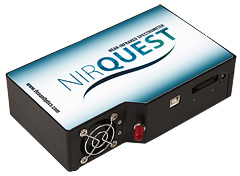您當(dāng)前的位置: 首頁(yè)-產(chǎn)品展示-NIRQuest 光譜儀
NIRQuest 光譜儀
2019/08/07

If you utilize NIR spectroscopy for research, process or diagnostics, NIRQuest is a less costly, less complex alternative to FT-IR and comparable technologies.
NIRQuest delivers a high-performance optical bench with low-noise electronics and more grating options than we've ever offered.
This compact, multi-interface spectrometer is available in version for 900-1700 nm, 900-2050 nm, 900-2200 nm and 900-2500 nm.
NIRQuest's modular design delivers more customization for a wider variety of applications including medical diagnostics, pharmaceuticals analysis, environmental monitoring and process control.
NIRQuest for Laser Analysis
NIRQuest is versatile enough to be configured for high-resolution laser and optical fiber characterization. The NIRQuest delivers reliable optical resolution to <0.25 nm (FWHM) and is easily customized for your high-resolution spectral applications.
Thulium Fiber Laser
Courtesy of Townes Laser Institute at the University of Central Floridas College of Optics & Photonics
Turn NIRQuest into a Network Spectrometer
When purchased with the Remora Network Adapter users can communicate with the NIRQuest over Ethernet or Wi-Fi. Use with SpectraSuite Software, and turn your device into a network accessible spectrometer. Remotely capture spectral data from anywhere Plus, Remora allows multiple users to access data and experiment settings without the need for additional equipment. Remora's web-interface works with all popular web browsers and allows you to monitor data from a PDA, iPhone, and most internet ready devices. - Learn more
| At a Glance | ||||
| NIRQuest512 | NIRQuest512-2.2 | NIRQuest256-2.1 | NIRQuest256-2.5 | |
| Detector: | Hamamatsu G9204-512 InGaAs linear array | Hamamatsu G9204-512W InGaAs linear array | Hamamatsu G9206-256 InGaAs linear array | Hamamatsu G9208-256 InGaAs linear array |
| Detector Range: | 850-1700 nm | 900-2200 nm | 900-2100 nm | 900-2550 nm |
| Useable range1: | 900-1700 nm | 900-2200 nm | 900-2050 nm | 900-2500 nm |
| Pixels: | 512 | 512 | 256 | 256 |
| Pixel size: | 25 m x 500 m | 25 m x 250 m | 50 m x 500 m | 50 m x 500 m |
| Entrance aperture: | 25 m wide slit (standard); also, custom options (10, 50, 100 or 200 m wide slits) or fiber (no slit) | 25 m wide slit (standard); also, custom options (10, 50, 100 or 200 m wide slits) or fiber (no slit) | 25 m wide slit (standard); also, custom options (50, 100 or 200 m wide slits) or fiber (no slit) | 25 m wide slit (standard); also, custom options (50, 100 or 200 m wide slits) or fiber (no slit) |
| Fiber optic connector: | SMA 905 | SMA 905 | SMA 905 | SMA 905 |
| Grating options (standard): | Grating NIR3, 150 l/mm, 900-1700 nm | Grating NIR2, 100 l/mm, 900-2050 nm | Grating NIR2, 100 l/mm, 900-2050 nm | Grating NIR1, 150 l/mm, 1075-2500 nm |
| Grating options (custom): | Gratings NIR10, NIR11, NIR12, NIR13 and NIR14 | Gratings NIR2, NIR3, NIR10, NIR11, NIR12 and NIR13 | Gratings NIR2, NIR3, NIR10, NIR11, NIR12 and NIR13 | Gratings NIR2, NIR3, NIR10, NIR11, NIR12 and NIR13 |
| Longpass filter2: | OF1-RG830 longpass NIR filter (optional) | OF1-RG830 longpass NIR filter (optional) | OF1-RG830 longpass NIR filter (optional) | OF1-RG830 longpass NIR filter (optional) |
| Wavelength range: | 900-1700 nm w/Grating NIR3 | 900-2150 nm w/Grating NIR2 | 900-2050 nm w/Grating NIR2 | 900-2500 nm w/Grating NIR1 |
| Optical resolution (FWHM)3: | ~3.1 nm w/25 m slit | ~4.6 nm w/25 m slit | ~7.6 nm w/25 m slit | ~ 9.5 nm w/25 m slit |
| Signal-to-noise ratio at full signal4: | >15000:1 @ 100 ms integration >13000:1 @ 1000 ms integration | >10000:1 @ 100 ms integration | 10000:1 @ 100 ms integration | 7500:1 @ 10 ms integration |
| A/D resolution: | 16-bit | 16-bit | 16-bit | 16-bit |
| Dark noise: | 6 RMS counts @ 100 ms 12 RMS counts @ 1000 ms | 6 RMS counts @ 100 ms 12 RMS counts @ 250 ms | 6 RMS counts @ 100 ms 12 RMS counts @ 250 ms | 8 RMS counts @ 10 ms 12 counts RMS @ 30 ms |
| Dynamic range: | 15 x 10^6 (system); 5000:1 for a single acquisition | 15 x 10^6 (system); 1000:1 for a single acquisition | 5 x 10^6 (system); 5000:1 for a single acquisition | 3 x 10^5 (system); 5000:1 for a single acquisition |
| Integration time5: | 1 ms-10 seconds | 1 ms-2000 ms | 1 ms-2000 ms | 1 ms-60 ms |
| Corrected linearity: | >99.8% | >99.8% | >99.8% | >99.8% |
| Computer interfaces: | USB 2.0 @ 480 Mbps; RS-232 (2-wire) @ 115.2 K baud | |||
| Wireless (Wi-Fi) interface: | Yes, with Remora adapter | |||
| Wi-Fi range: | 25 meters in free space | |||
1 Useable range?is defined in the context of the NIRQuest models detector response and its typical grating response. For example, the 512-element detector has response at 850 nm, but grating response begins at 900 nm. The G9206 256-element detector response is sensitive to TEC temperature, and has response only to 2050 nm when the TEC is set to -20 C. The G9208 256-element detector has response to 2550 nm, but the grating efficiency drops off at 2500 nm. 2 Other filter options are available for order-sorting in the NIRQuest256-2.1 and NIRQuest256-2.5. Please contact an Applications Scientist for details. 3 Optical resolution (FWHM) depends on grating and slit selection. 4 SNR will decrease at longer integration times. 5 Maximum integration times are defined as the longest amount of time one can integrate the spectrometer before the dark level rises to half of full scale. | ||||



